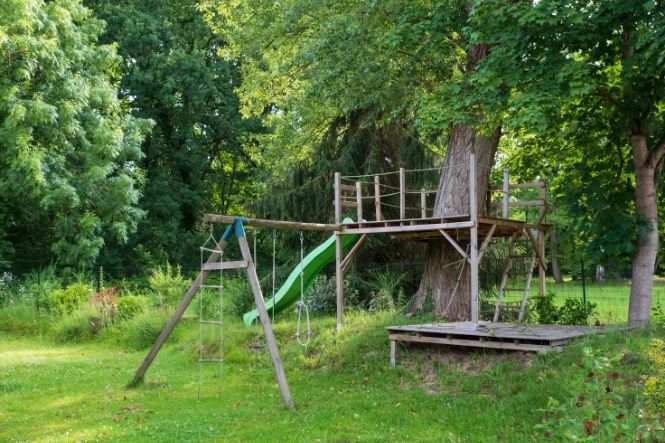Although trips and falls are an everyday part of the growth and development of children, this doesn’t necessarily mean you should go out of your way to make a garden unfriendly to them. On the other hand, does the compensation culture in the UK mean that we have to cover our kids in cotton wool before sending them to play outside our homes? Or is there a happy medium somewhere?
High Points are the Worst
One of the points to consider when looking at children’s play areas is the height they can fall from. The Royal Society for the Prevention of Accidents (RoSPA) says that the most common accidents in playgrounds are from falling from one level to another. So you might want to pay more attention to child safety in the garden where there are slides, climbing frames, swings and the like.
Commercially available playing surfaces used in parks, schools and other public play areas are probably too costly to install on a domestic scale. They are mostly poured, in the same way that concrete is, onto a prepared surface, and to get the specialists involved is likely to be prohibitively expensive. Having said that, some of the manufacturers have tiled products that they make available to the domestic market, although they will still cost quite a lot.
Loose Materials
A common and much cheaper alternative is to use a loose surface, such as sand, pea shingle or wood chips. With all of these, although the initial layout is cheap, the ongoing costs are higher as the materials compact and disperse, which means they need to be topped up regularly. Sand is usually confined to a sand pit, because its small grain size makes it difficult to contain. It’s also a significant headache for cleaning clothes, shoes and children, as it gets everywhere and is hard to brush off, so is probably not suitable for a large play area in a garden.
Pea shingle isn’t as small as sand (the grains are usually about 1cm in diameter) but it can still get everywhere. To get a reasonable level of impact absorption you need to lay it to quite a depth, probably between 15-20cm (6-8in), and bear in mind that children are likely to throw it at each other and push it into each other’s orifices. But it does drain well, so kids can be out in it quite soon after rain has stopped, and it doesn’t have to be topped up as much as organic products that biodegrade.
Wood bark Mulch Or Chips (sometimes called ‘play bark’ in the trade) is a common sight in playgrounds these days. It drains well but also absorbs a lot of water, so it can feel wet to the touch for some time after it has stopped raining. It degrades as well as compacts, so has to be topped up regularly and, although the main chunks of bark stay in place quite well, little chips and other smaller pieces can stick to clothing and be tracked into the house.
Why not use Grass?
Although it may be the last thing that will occur to a safety conscious parent desperate to buy the best for their offspring, how about grass? The chances of keeping a lush lawn are low if children are playing on it every day, but it can be resilient, especially if it is left to grow longer than usual and has wild flowers mixed in with it. Of course, that’s the complete opposite of the manicured lawn that many gardeners aspire to, but perhaps that’s a compromise that needs to be made for a few years. And what product could be ‘greener’?
If you have a dedicated area where there are swings, a climbing frame or trampoline, you can perhaps lay a grass mat. These are rubber or plastic membranes that go over existing grass, protecting the roots of the lawn and providing a more solid surface for kids’ feet. The grass will grow through the membrane holes in time, making the mat virtually invisible, and the grass can then be cut as usual.


